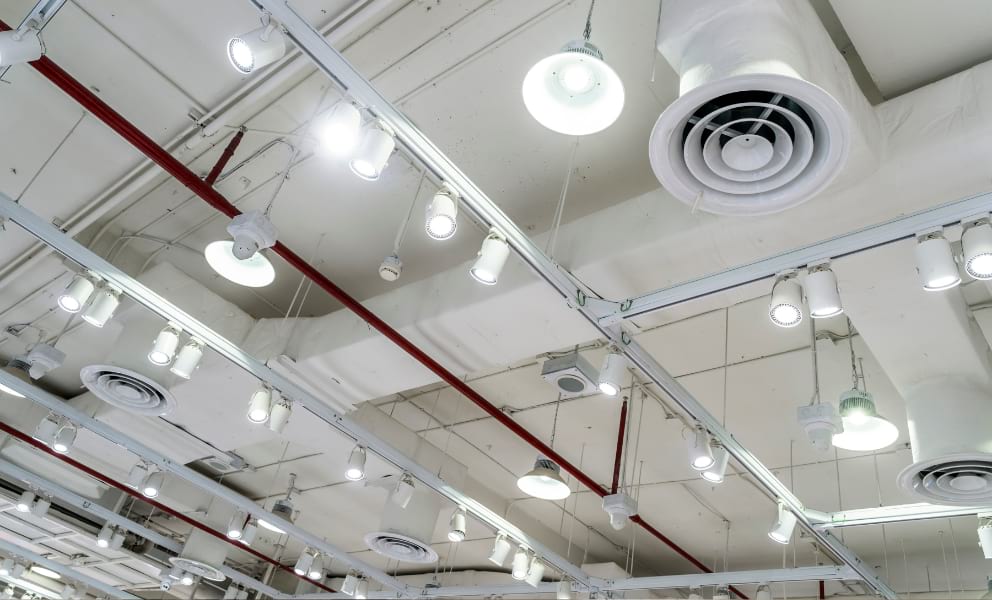
Since we spend an estimated 94 percent of our time indoors1, indoor environmental quality (IEQ) is critical. Along with indoor air quality, thermal comfort and acoustics, lighting represents one of four key factors comprising IEQ. The right lighting offers a wealth of benefits so it can play a powerful role in determining your building’s IEQ.
Here are seven ways that lighting can positively impact IEQ:
1. Enhance Visibility: Improving lighting can reduce the likelihood of slips, trips, and falls by avoiding perils in hallways, walkways and stairways. According to OSHA2, “Inadequate lighting impairs vision and the ability to see hazards. Proper lighting, on the other hand, allows employees to see their surroundings and notice unsafe conditions in time to avoid them.”
2. Support Natural Circadian Rhythms: According to Sleep Foundation, “light is the most powerful influence on circadian rhythms”3. A 2019 study of shift work published in Nature found that “alertness and performance remain most impaired during night shifts given the lack of circadian adaptation to night work”4 (Ganesan, S., Magee, M., Stone, J.E. et al.) Today’s lighting systems can improve daytime circadian stimulus by providing sufficient brightness and light quality and using dimming and color-tuning strategies to control exposure.
3. Enhance Productivity: Improving workplace lighting can optimize productivity. After leaders installed human-centric lighting featuring a “circadian-friendly” lighting sequence at a property company, they recorded an employee-perceived productivity increase of 18 percent according to research conducted by The Twente University, the Free University Amsterdam5. The study also found that after lighting improved, employees improved their work accuracy by 12 percent, 78 percent of employees described feeling happier, and 78 percent reported that they felt healthier5.
4. Help Improve the Learning Environment: LED lighting also can be used to help improve the classroom learning environment. A study, published in the journal Optics Express6 in 2016, “suggests that just-right dynamic lighting can support student classroom learning”7. This study6 found that students felt more alert and scored higher on their tests when they were in a classroom with 6,500 K lighting, a cool, blueish-white that mimics natural daylight when compared with two other kinds of lighting.
Today's LED lighting offers the ability to control both the light level and the color of the illumination. In the past, teachers have covered lights in their classrooms with blue cloth or tissue paper to help create "visually appropriate classroom environment." A recent study found that "There was a clear trend, where adding more saturated blue and/or dimming the lights provided higher acceptance and more frequent feelings of calmness during study hall, while not compromising the students’ focus."8
5. Support Healing: Research has found that adequate and appropriate exposure to light is critical for the health and well-being of patients as well as staff in healthcare settings9 LEDs Magazine reports10 that human-centric LED lighting can impact perceptions of well-being at healthcare and senior living facilities. These effects can include positive impacts for people suffering from Alzheimer’s disease and related dementias (ADRD) reducing rates of depression, agitation and falls. According to LEDs magazine, “in a recent study, a 24-hour controlled LED lighting scheme increased night time sleep in ADRD patients by 24 percent and reduced behaviors like nocturnal wandering, agitation, and abusive outbursts.”10
LED lighting also can be used to mimic natural lighting to support patients’ needs11. Researchers at the Lighting Research Center at Rensselaer Polytechnic Institute in Troy, New York, report that using special circadian lighting can help hospital patients get a good night’s sleep and that the benefits of adequate sleep may speed healing and recovery.
6. Help Reduce Germ Transmission: Today’s LED lighting can be easily controlled through applications to provide touchless control, which can lead to reduced transmission of germs. For example, some touch-free lighting switches can be activated with a hand wave, which eliminates the potential for germ transmission from touching the light switch. Adding ultraviolet germicidal irradiation (UVG)) is another way to use light to reduce air and surface contaminants.
7. Provide Real-Time Tracking - Smart lighting can now incorporate real-time location services (RTLS) which function as an indoor GPS that provides instant information about the real-time location of people and equipment. RTLS can be used to track a variety of assets including staff badges, wheelchairs and expensive medical equipment such as ultrasound machines that may get moved from room to room.
Remember to consider the powerful role that the right lighting can play in your building when assessing your IEQ. Learn how you can improve your building’s lighting and its overall IEQ with Wellsphere from Trane.
1 Trane Technologies, Life Indoors, Understanding Environmental Quality, Trane Technologies IEQ Primer
2 OSHA Academy, “Slip, Trip and Fall Prevention for Healthcare Workers”, page 10
3 Suni, E., Jan. 20, 2022, Circadian Rhythm, Sleep Foundation
4 Ganesan, S., Magee, M., Stone, J.E. et al., March 15, 2019, The Impact of Shift Work on Sleep, Alertness and Performance in Healthcare Workers
5 Editorial Staff, Lighting Design, Jan. 5, 2018, Research Shows Lighting Supports Healthy Offices,
6 Choi, K. and Suk, H-J, 2016, "Dynamic lighting system for the learning environment: performance of elementary students,"
7 Howard, J., April 29, 2016, How Just the Right Lighting May Improve Learning in Classrooms,” Huffpost, April 29, 2016,
8 Thayer, Allison, “Lighting to Tranform SPED Classrom Environments, Designing Lighting, Vol. 2, issue 5, pp. 16-18.
9 Joseph, A., PhD., 2006, Impact of Light on Outcomes in Healthcare Settings, Published by the Center for Healthcare Design.
10 Smart, D., Aug. 29, 2016, https://www.ledsmagazine.com/specialty-ssl/article/16678709/the-piper-senior-assisted-living-facility-achieves-health-benefits-with-biostar-led-lighting
11 Jenkins, K., Feb. 28, 2018, “Shine a Healing Light: Circadian-Based Lighting in Hospitals,” MedScape,
Wellsphere

About the author
Ellen Helm, Director of Lighting Strategy
Ellen Helm is the Director of Lighting Strategy for Trane’s Commercial HVAC America’s business. In this role, Ellen leads a national lighting team that strives to provide high value, customer focused lighting solutions that deliver energy efficiency, sustainability and resiliency while also improving building infrastructure and the health and well-being of the occupants.
Ellen graduated from Valparaiso University with a Bachelor of Science in Electrical Engineering and has an MBA from the University of Colorado at Denver. She has authored multiple whitepapers on lighting and is a passionate advocate for lighting education and the creation of better lighting standards. Ellen currently lives with her husband in Crystal Lake, IL. She has three children living in Milwaukee and enjoys spending time with family and her Fox Red Labrador “Little Miss Ruby” whenever possible. She also enjoys outdoor activities and fitness.











































































